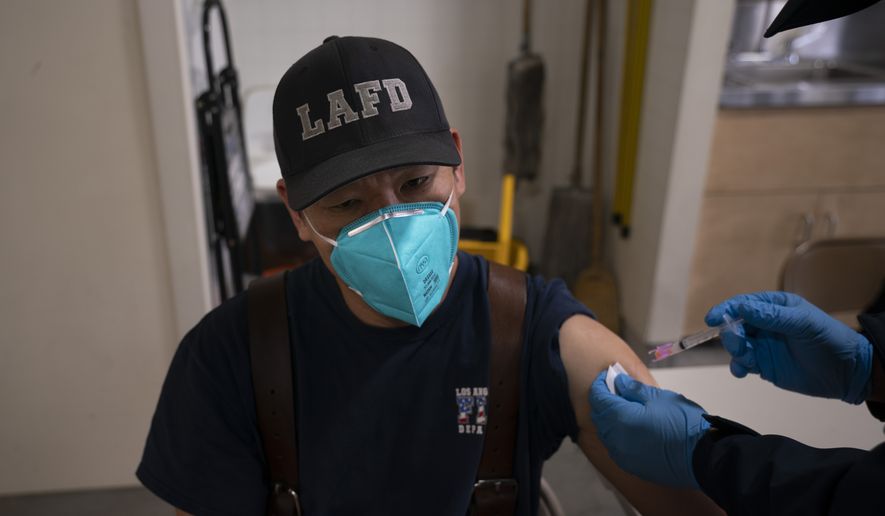The White House said Wednesday it is exploring whether it is possible to make coronavirus vaccines at sites that aren’t involved now, as President Biden faces intense pressure to one-up the Trump plan he dubbed a “dismal failure” and Republicans accuse him of coasting on his predecessor’s groundwork.
Biden adviser Andy Slavitt said the administration is looking at wielding the Defense Production Act — a wartime production law — to maximize production but tempered expectations, saying it isn’t easy to retrofit other companies’ operations.
“That’s something that’s under active exploration. As you can imagine, it’s not as simple as walking in and flipping a switch,” said Mr. Slavitt, who helped President Obama rescue HealthCare.gov in late 2013. “These are delicate processes, very sterile processes, and have to be done in a way that actually completely works, but we will not be afraid to explore every option to get more vaccines to the public as quickly as possible.”
Experts said converting other supply chains to manufacture biologics is “not impossible” but will run into cold realities. The process involves the transfer of manufacturing steps, equipment, temperature know-how, chemical reagents and biological resources.
Moderna, which makes one of the two vaccines being used in the U.S., told The Washington Times it had no comment on what conversations may or may not be underway and “there are no announce-able events.”
Fellow vaccine makers haven’t signaled any moves, either, though French pharmaceutical company Sanofi made headlines Wednesday by saying it will give Pfizer access to its manufacturing infrastructure and expertise in Germany this summer because the latter company beat it to the punch in developing a vaccine.
Brook Baker, a law professor at Northeastern University who tracks COVID-19 supply issues, said Sanofi will perform “fill and finish,” or putting Pfizer’s active vaccine components into vials of sterile solution.
“Repurposing full vaccine manufacture is obviously more difficult, though it is somewhat easier if the same base vaccine technology exists in both companies,” he said.
He noted that AstraZeneca and Oxford University managed to transfer their technology quickly to the Serum Institute, a large vaccine manufacturer in India.
For now, the Biden administration is trying to maximize existing agreements with Pfizer-BioNTech and Moderna, while waiting for new vaccines from Johnson & Johnson and other suppliers to become available.
“We don’t want to make a commitment to the public based on things that have not been accomplished,” Mr. Slavitt said.
Mr. Biden promised to shake up the federal COVID-19 response, but many of his early moves are a continuation of the Trump era, which faced similar challenges.
Michael Bars, a communications aide in the Trump White House, said many federal workers already bought into mask-wearing, which Mr. Biden last week mandated on federal property, and the prior administration made frequent use of the Defense Production Act to procure supplies for vaccines and other parts of the response.
“A lot of people on both sides of the aisle were expecting something more novel. Perhaps the most unusual part about the Biden plan is that it sets targets for vaccine administration that were in fact already exceeded by the outgoing Trump administration,” Mr. Bars said.
Mr. Biden has a goal of 100 million shots in his first 100 days, though he has acknowledged he should set his sights higher, as House Minority Whip Steve Scalise of Louisiana and other Republicans needle him over the modesty of his target.
Mr. Slavitt said 100 million shots will be the “floor, not the ceiling” of their ambitions as the new administration pleads for time, saying progress will come as its efforts to understand the supply chain and bolster state efforts with federal muscle take root.
“It’s about day-to-day execution,” Mr. Slavitt said.
For now, Mr. Biden is touting incremental improvements, such as giving states a longer view of how many vaccines they will receive each week, while telling Americans to mask up or maintain physical distancing while the vaccines roll out, saying it will take months to get vaccines to everyone who wants one.
The nation’s weekly allotment of the Moderna vaccine rose 16%, though Mr. Biden hasn’t announced a plan for bolstering underlying production beyond the procurement of syringes that pull an extra dose from Pfizer’s vaccine vials.
Mr. Baker said if Mr. Biden can use the Defense Production Act to manufacture more doses, vaccine makers likely would maintain control of sales and distribution to their established customers. The companies struck deals with many countries.
He argued the Biden team should use the act to boost global supply instead of domestic supply alone, given that Americans will remain vulnerable to dangerous mutations until the world is vaccinated.
• Tom Howell Jr. can be reached at thowell@washingtontimes.com.




Please read our comment policy before commenting.